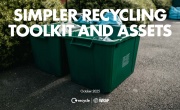Ocean Cleanup barrier to be tested in Dutch waters

The organisation, which was set up by 21-year-old entrepreneur Boyan Slat in 2013, aims to develop technologies to extract, prevent and intercept plastic pollution. Deploying the barrier off the coast of The Hague represents the latest testing stage of the technology, which the organisation hopes will eventually be deployed in the Pacific Ocean.
The structure’s floating barriers are designed to catch plastic deposited by the natural ocean currents. Most of the current will pass underneath, carrying away sea life and preventing by-catch. Plastics are funnelled towards the centre of the structure, enabling a central platform to extract and store the concentrated plastic until it is transported to land for recycling. The barriers are intended for large-scale use with the aim of harvesting plastic from millions of square kilometres.
According to feasibility studies, the floating dam is able to passively ensnare 80 per cent of plastic pollution that passes through.
Testing ahead of Pacific pilot

Deploying this barrier segment is the next step after extensive computer modelling and scale model testing by the Deltares research institute and in the Maritime Research Institute Netherlands (MARIN) off-shore basin facility..
The results of the North Sea test will determine if the organisation will go ahead with the Coastal Pilot, a 2,000 metre-long capture system due to be deployed in the second half of 2016 off the coast of Tsushima Island in Japan.
Both tests are a part of The Ocean Cleanup’s efforts to develop a passive technology to clean up the world’s oceanic ‘garbage patches’. These are formed by gyres (rotating ocean currents) such as the North Pacific Gyre, which traps marine debris and has created the largest of these patches: the Great Pacific Garbage Patch.
The Great Pacific Garbage Patch, also called the Pacific trash vortex, covers an area estimated to be between 270,000 and 5,800,000 square miles. It is thought to contain a third of the world’s oceanic plastic. Pending the success of the two trials, researchers hope to deploy a 62 mile-long V-shaped barrier in this area in 2020.
Cleanup will lead to prevention
Writing in a blog on the Ocean Cleanup website last month (December), Slat wrote: ‘A cleanup project has the potential to make the problem visible, and helps people become aware of the problem in general. In the future, it would also allow us to develop spin-off technologies to intercept plastic in rivers before it reaches the ocean. It is very difficult to adapt a system designed for rivers to work on the ocean, but once you have something that works in the worst conditions on the face of the planet, I think it should be relatively easy to scale it down to fit the riverine environment.
‘Prevention does not mitigate the need for a cleanup operation. Considering the scale of the problem, I would argue that it is key to tackle the problem from both angles. We’ve always been told that the best thing we could do is not make it worse. But don’t we all want the future to be better than the past? A cleanup will make that possible.’
More information on the project can be found at The Ocean Cleanup’s website or in Resource’s in-depth interview with Boyan Slat.






